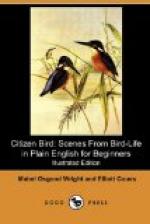“I guess we had better tie up yonder,” said Olaf, when they had gone a couple of miles up the river. “And then I can put the children in the little boat and pole them in among the reeds.”
So the Doctor and Olive went ashore, where the sharpie was tied to the end of what had once been a small wharf, while Dodo, Nat, and Rap crouched down in the dingey, obeying Olaf’s order to keep very still and not make the boat tip.
The little reed-bordered creek that they entered was quite narrow, and soon grew to be only a thread of water, where they could touch the reeds on both sides. They heard many rustling sounds, but for some time could see nothing. Olaf, who was watching, suddenly laid down his pole, and seizing an oar gave the water two or three sharp slaps. Instantly half a dozen strange-looking birds started out, flapping and sprawling, with their legs dangling, one or two seeming to slide across the water, till they all disappeared among the flags again.
“Oh! how funny they are!” cried Nat. “They have such foolish-looking faces, little perky tails like a Wren’s, and such long, loose feet! Why didn’t they fly instead of dodging about so—are their nests in the reeds?”
“They do nest here; but now that the season is over, they stay about picking up food from the mud until they shift southward a piece for the winter. These Rails fly well enough when they once get started, and go a long way without stopping. But they are lazy about it in their summer homes, where they only flap up and then dodge down again to hide; so they are easy shooting—too easy to be any sport. It’s what I call killing, not hunting.”
[Illustration: Virginia Rail.]
“What a strange note they have,” said Rap. “Something like a Woodpecker’s call.”
“Yes, but you should hear the noise they make in spring, when there are crowds of birds along the river and back in the meadows. The Redwings and Meadowlarks sing all day long, the Marsh Wrens come along to join in, the Snipe begin to call, the Spotted Sandpipers whistle up, and we get a visit from the Wild Geese as they fly north. I tell you it is fine to be down here then. But in fall I’d rather be up at the lake by the lumber camp when the snow brings the foxes and other wild animals out.”
“Do stop a minute, please, Olaf, and don’t tell quite so fast,” pleaded Dodo. “Uncle Roy never does. You have said the names of ever so many birds that we don’t know, and when he does that he always stops and explains. Snipe and Spotted Sandpipers—please begin with those.”
Olaf thought for a minute. He knew all the game and water birds—in fact, they were intimate friends of his; but it was not so easy for him to describe them.
“Did you ever see a Woodcock?” he began.
“Yes, oh yes!” cried Nat. “Uncle Roy showed us a stuffed one in the wonder room, and told us all about its long beak with a point like a finger to feel for its food in the mud because its eyes are too far back to see well in front, and all about its sky dance; and Rap has seen one sitting on its nest in a spring snowstorm.”




